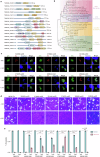Regulation of the developmental programs in Toxoplasma by a novel SNF2L-containing chromatin remodeling complex
- PMID: 40593611
- PMCID: PMC12215852
- DOI: 10.1038/s41467-025-60795-1
Regulation of the developmental programs in Toxoplasma by a novel SNF2L-containing chromatin remodeling complex
Abstract
Toxoplasma gondii is an extremely successful parasite infecting one third of the human population and numerous animals. It has a complex life cycle with multiple developmental stages that are key for its transmission and pathogenesis. But how the developmental programs are regulated is largely unknown. Here, we screen putative chromatin remodeling proteins in T. gondii and find that a novel complex containing an evolutionarily conserved ATPase SNF2L is critical for programming the parasite's development. This complex contains four core proteins and conditional depletion of three of them leads to similar expression changes of developmentally regulated genes, including increased transcription of genes involved in sexual commitment and development. Accordingly, depletion of SNF2L causes merogony and out-budding types of division, which are otherwise only observed at the enteroepithelial stages within definitive hosts where sexual reproduction of the parasite occurs. After being recruited to target regions, SNF2L regulates gene expression by modulating local chromatin accessibility or by recruiting accessory proteins to its binding sites, thus ensuring that the gene expression and reproduction patterns are matched to the life cycle stages. Conditional depletion of SNF2L offers an opportunity to study the unique biology of the parasite during pre-sexual and sexual developments in vitro.
© 2025. The Author(s).
Conflict of interest statement
Competing interests: The authors declare no competing interests.
Figures






Similar articles
-
A cathepsin C-like protease mediates the post-translation modification of Toxoplasma gondii secretory proteins for optimal invasion and egress.mBio. 2023 Aug 31;14(4):e0017423. doi: 10.1128/mbio.00174-23. Epub 2023 Jun 16. mBio. 2023. PMID: 37326431 Free PMC article.
-
Elucidating the Role of Toxoplasma gondii's Mitochondrial Superoxide Dismutase.Biomolecules. 2025 Jul 7;15(7):972. doi: 10.3390/biom15070972. Biomolecules. 2025. PMID: 40723844 Free PMC article.
-
AP2X-1 is a negative regulator of Toxoplasma gondii sexual commitment.mBio. 2025 Aug 15:e0005225. doi: 10.1128/mbio.00052-25. Online ahead of print. mBio. 2025. PMID: 40823841
-
Psychological interventions for adults who have sexually offended or are at risk of offending.Cochrane Database Syst Rev. 2012 Dec 12;12(12):CD007507. doi: 10.1002/14651858.CD007507.pub2. Cochrane Database Syst Rev. 2012. PMID: 23235646 Free PMC article.
-
Health professionals' experience of teamwork education in acute hospital settings: a systematic review of qualitative literature.JBI Database System Rev Implement Rep. 2016 Apr;14(4):96-137. doi: 10.11124/JBISRIR-2016-1843. JBI Database System Rev Implement Rep. 2016. PMID: 27532314
References
MeSH terms
Substances
Grants and funding
LinkOut - more resources
Full Text Sources

